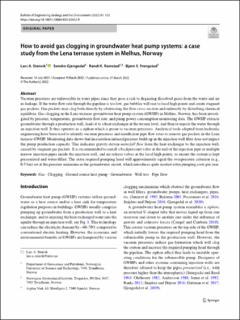| dc.contributor.author | Stenvik, Lars Aaberg | |
| dc.contributor.author | Gjengedal, Sondre | |
| dc.contributor.author | Ramstad, Randi Kalskin | |
| dc.contributor.author | Frengstad, Bjørn S. | |
| dc.date.accessioned | 2023-01-13T09:01:21Z | |
| dc.date.available | 2023-01-13T09:01:21Z | |
| dc.date.created | 2022-03-22T10:16:29Z | |
| dc.date.issued | 2022 | |
| dc.identifier.citation | Bulletin of Engineering Geology and the Environment. 2022, 81 (4), . | en_US |
| dc.identifier.issn | 1435-9529 | |
| dc.identifier.uri | https://hdl.handle.net/11250/3043249 | |
| dc.description.abstract | Vacuum pressures are unfavorable in water pipes since they pose a risk to degassing dissolved gases from the water and air in-leakage. If the water flow rate through the pipeline is too low, gas bubbles will rise to local high points and create stagnant gas pockets. Gas pockets may clog both directly by obstructing the flow cross-section and indirectly by disturbing chemical equilibria. Gas clogging in the Lena terrasse groundwater heat pump system (GWHP) in Melhus, Norway, has been investigated by pressure, temperature, groundwater flow rate, and pump power consumption monitoring data. The GWHP extracts groundwater through a production well, leads it to a heat exchanger at the terrain level, and then re-injects the water through an injection well. It thus operates as a siphon which is prone to vacuum pressures. Analytical tools adapted from hydraulic engineering have been used to identify vacuum pressures and insufficient pipe flow rates to remove gas pockets in the Lena terrasse GWHP. Monitoring data shows that incrustation induced pressure build-up in the injection well filter does not impact the pump production capacity. This indicates gravity driven waterfall flow from the heat exchanger to the injection well, caused by stagnant gas pockets. It is recommended to install a backpressure valve at the end of the injection pipe or multiple narrow injection pipes inside the injection well, and air release valves at the local high points, to ensure the system is kept pressurized and water-filled. The extra required pumping head will approximately equal the overpressure criterion (e.g., 0.5 bar) set at the pressure minimum in the groundwater circuit, which introduces quite modest extra pumping costs per year. | en_US |
| dc.language.iso | eng | en_US |
| dc.publisher | Springer Nature | en_US |
| dc.rights | Navngivelse 4.0 Internasjonal | * |
| dc.rights.uri | http://creativecommons.org/licenses/by/4.0/deed.no | * |
| dc.title | How to avoid gas clogging in groundwater heat pump systems: a case study from the Lena terrasse system in Melhus, Norway | en_US |
| dc.title.alternative | How to avoid gas clogging in groundwater heat pump systems: a case study from the Lena terrasse system in Melhus, Norway | en_US |
| dc.type | Peer reviewed | en_US |
| dc.type | Journal article | en_US |
| dc.description.version | publishedVersion | en_US |
| dc.source.pagenumber | 11 | en_US |
| dc.source.volume | 81 | en_US |
| dc.source.journal | Bulletin of Engineering Geology and the Environment | en_US |
| dc.source.issue | 4 | en_US |
| dc.identifier.doi | 10.1007/s10064-022-02652-9 | |
| dc.identifier.cristin | 2011635 | |
| cristin.ispublished | true | |
| cristin.fulltext | original | |
| cristin.qualitycode | 1 | |

